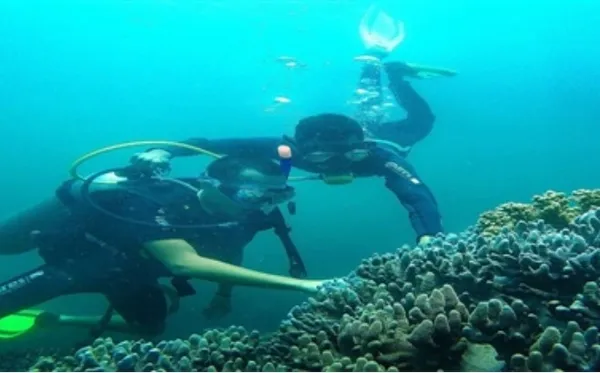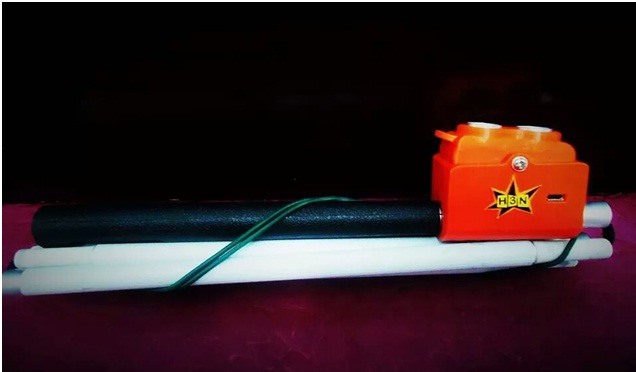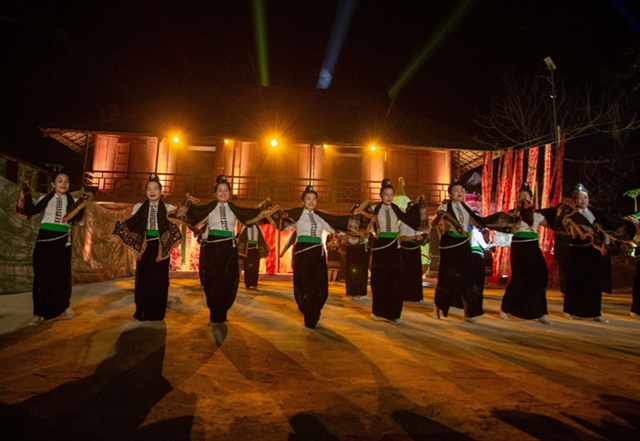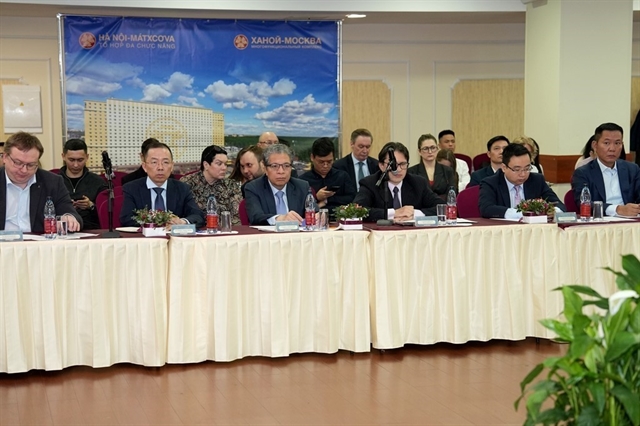 Features
Features

The blind now can identify their surrounding obstacles more easily thanks to a smart stick that has recently been created by three former students of Gia Định Information Technology University in HCM City.
 |
| Latest model: The new version of H3N smart stick is lighter and integrate many other functions like battery charging. — Photo courtesy of Võ Chí Hiếu |
by Phương Hà
The visually impaired people now can identify their surrounding obstacles more easily thanks to a smart stick that has recently been created by three former students of Gia Định Information Technology University in HCM City.
Named H3N, the smart stick was designed based on the form of folding canes that are normally used by the blind or visually impaired. It is made of aluminium, weighs 390g and is 1.2m long. It makes use of the ultrasound technique to navigate obstacles within a 2.5m distance. As long as an obstacle is recognised, the chip on the stick will receive signals and then announce the same to the user via vibrations so that they can change direction.
The idea for a smart stick for the blind came to Võ Chí Hiếu, Võ Thanh Nguyên and Lê Thanh Hải when the three young men witnessed a blind man bumping against the back of a lorry while walking -- an incident they continued to obsess over for long.
They decided they needed to do something to alleviate the hardships faced by the blind.
“We all have good eyesight, which is our fortune, so our group wanted to do something for the less fortunate,” Hiếu said.
At the start, lots of questions kept popping in their minds and together they tried to seek answers.
They realised the most common sticks like Smart Cane and Ultra Cane that were being used by the blind at that time only helped them navigate the way and feel obstacles on the floor based on their intuition. However, obstacles at a higher position, above the knees, were difficult to identify.
Additionally, although there were many devices for the blind which offered them convenience while performing daily activities, they were rare and costly.
 |
| Do-gooders: (From left to right), Lê Mạnh Hải, Võ Thanh Nguyên and Võ Chí Hiếu, the three men who created the smart sticks for the visually impaired. — Photo courtesy of Võ Chí Hiếu |
The desire to address these difficulties faced by the blind motivated the three young men to find solutions. However, it was only in their final year at university when they had an opportunity to practise at the HCM Institute of Physics and Biomedicine, which specialises in creating devices for the blind, was their wish realised.
There they were provided with more professional knowledge which was essential for their research and creation of the smart stick.
The three students began to regularly visit special homes or schools for the blind, follow blind street vendors, live with them, and even blindfold themselves to truly understand the difficulties faced by those who were unfortunate to not be able to see the sunlight. These unforgettable experiences helped the group envision their future product.
However, since they were not professionally trained in mechatronics, they encountered hugechallenges.
The ultrasound technique is utilised in the stick to recognise obstacles. Although they successfully created the engine, their dream was not fulfilled because the stick continuously gave out signals, making the user bewildered and led to him/her losing direction. They finally discovered that the reason was due to the low position of the engine.
Then came another problem. “Our engine was too heavy so it took up to two seconds to warn the user from the moment the obstacle was identified,” Hiếu said.
“After days of following the blind, we discovered they walked quite fast. Two seconds can be too long for them because within that time they can bump against the obstacle in front. We had to dismantle everything and start our research again.”
“We accidentally learned about the vibration engine of the mobile phone, which can vibrate pretty well, even though it is small and less heavy. This engine would therefore be less bulky,” he added.
 |
| Improved navigation: The smart ultrasound wave stick helps the visually impaired to identify surrounding obstacles more easily. Photo tiepthigiadinh.vn |
Aspiration to innovate
As soon as the first product was created successfully, it was given to the blind for trial use to get feedback.
“We gave the stick to the blind and secretly followed them to see if it functioned properly, and we were happy that it worked,” Hiếu said.
After receiving the bronze medal at the third contest for designing-creating-applying organised by HCM City’s Youth Union in 2015, Hiếu and his two friends collaborated with Firststep Fund to mobilise financial support from the community to create and improve their products, which could be provided to the blind for free.
“The lack of knowledge or skills in marketing and media also led to many difficulties. We had to persuade others with "good eyesight" to understand the difficulties faced by the blind so that they would contribute to our project financially,” he said.
Their first success did not seem to satisfy the three young inventors. Despite facing the pressure of finding jobs as graduates, they still aspired to perfect their product, by making it lighter and integrating many other functions such as battery charging.
“We still need to work on how to make the stick recognise the direction in which the obstacle is located,” he continued.
Every weekend, Hiếu drops by the electronic repair workshops that, he says, will provide him with more practical experience.
“Every little bit of knowledge will accumulate gradually to help find solutions for the big issues, which is also the secret of turning a person who knows nothing into a creator,” he said
Eventually, eight more perfect smart sticks were created and given to the visually impaired in Thiên Ân Social Protection Institute in HCM City recently. A small ceremony was held, where one witnessed great happiness and tears on both sides.
“I am very happy today,” Nguyễn Minh Tuấn, representative of the institute at the ceremony, said. “I am happy because the blind students were given the sticks for free, because they will now become more independent, and moreover, because it is heartening to know that society has many youths who are both creative and kindhearted. They have given us much hope in life.”
"A new version of the H3N stick has come out early this year, but has not been commercialised yet due to personal reasons. But visually impaired people can purchase our sticks on our facebook page. Its current price is about VNĐ 1,9 million (US$80)," Hiếu said.
Hiếu said his group is expecting to receive more investment towards helping more visually impaired people own a H3N stick at a low cost.— VNS




